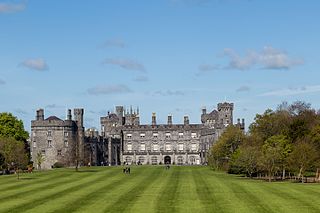
Kilkenny is a city in County Kilkenny, Ireland. It is located in the South-East Region and in the province of Leinster. It is built on both banks of the River Nore. The 2022 census gave the population of Kilkenny as 27,184, the thirteenth-largest urban center in Ireland.

Ardee is a town and townland in County Louth, Ireland. It is located at the intersection of the N2, N52, and N33 roads. The town shows evidence of development from the thirteenth century onward but as a result of the continued development of the town since then much of the fabric of the medieval town has been removed. The town is in a civil parish of the same name.
The architecture of Ireland is one of the most visible features in the Irish countryside – with remains from all eras since the Stone Age abounding. Ireland is famous for its ruined and intact Norman and Anglo-Irish castles, small whitewashed thatched cottages and Georgian urban buildings. What are unaccountably somewhat less famous are the still complete Palladian and Rococo country houses which can be favourably compared to anything similar in northern Europe, and the country's many Gothic and neo-Gothic cathedrals and buildings.

The Tholsel, also known as City Hall, is a municipal building in the High Street, Kilkenny, County Kilkenny, Ireland. It served as the meeting place by Kilkenny Borough Council until the council was abolished in 2014.

Ravensdale is a village, townland and electoral division located at the foothills of the Cooley Mountains on the Cooley Peninsula in the north of County Louth in Ireland. Bordering with the townland of Doolargy, Ravensdale is approximately 8 km to the north of Dundalk. The dual carriageway between Dublin and Belfast runs nearby, and the R174 connects it with Jenkinstown.
A tolbooth is a traditional Scottish 'town hall' for the administration of burghs, usually providing a council meeting chamber, a court house and a jail.
William Vitruvius Morrison was an Irish architect, son and collaborator of Sir Richard Morrison.
John Bowden was an Irish architect and member of the Board of First Fruits of the Church of Ireland from 1813 to 1821. He was born in Dublin and died in 1822.
In Ireland, the term city has somewhat differing meanings in Northern Ireland and the Republic of Ireland.
John Benjamin Keane was an Irish architect of the 19th century. (d.1859). He was engineer on the River Suir navigation.

A tolbooth or town house was the main municipal building of a Scottish burgh, from medieval times until the 19th century. The tolbooth usually provided a council meeting chamber, a court house and a jail. The tolbooth was one of three essential features in a Scottish burgh, along with the mercat cross and the kirk (church).

Shee Alms House was founded by the Shee family in 1582 'to accommodate twelve poor persons' in the city of Kilkenny, Ireland. It is a nationally significant Tudor period almshouse.
Grace's Old Castle is a historic castle building in the centre of Kilkenny which has been extended to create the city’s modern courthouse structure. It houses one of the oldest courthouses in the country.
Christchurch Place is a street in central Dublin, Ireland, formerly known as Skinners Row or Skinner's Row, it formed one of the main thoroughfares in medieval Dublin.
William Henry Byrne was an Irish architect who mainly designed churches. He studied under James Joseph McCarthy before going into business with John O’Neill in 1869. He worked on his own after O'Neill's death in 1883.

The Tholsel was an important building in Dublin which combined the function of civic hall, guildhall, court and gaol. It was located on Skinners Row within the old city walls of Dublin, Ireland. It existed in various forms from after the Norman invasion of Ireland until it was finally demolished around 1809. It was one of the most important and imposing buildings in medieval Dublin and was a secular focal point within the city walls situated at a major crossroads close to Dublin Castle, St Patrick's Cathedral and Christchurch Cathedral. It was the first of several tholsels which were constructed in the major cities and towns of late medieval Ireland and the Dublin tholsel also housed the first public clock in Ireland on its tower from 1466.

The Tholsel is a municipal building in West Street, Drogheda, County Louth, Ireland. Formerly the meeting place of Drogheda Borough Council, it is currently used as a tourist information office.















